| |

|

|
| |
|
Portuguese India |
| |
 |
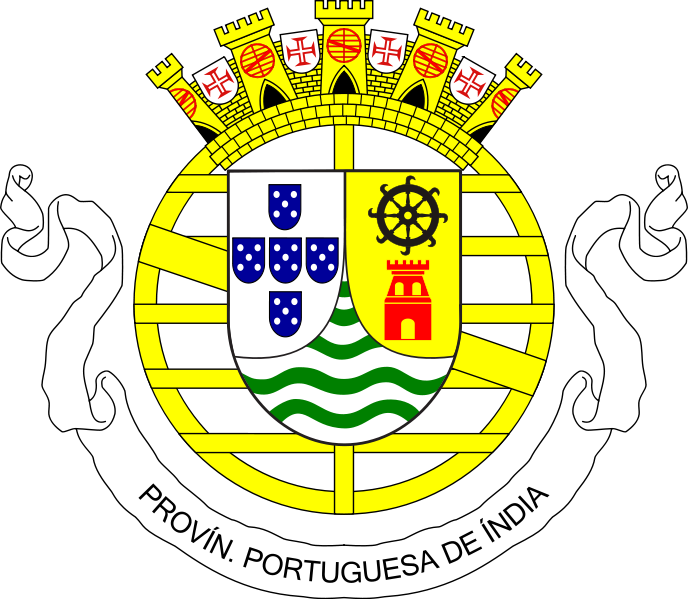 |
| |
The Portuguese Viceroyalty of India (Portuguese: Vice-Reino da
Índia Portuguesa), later the Portuguese State of India
(Portuguese: Estado Português da Índia), was the aggregate of
Portugal's colonial holdings in India.
The government started in 1505, six years after the discovery of
a sea route to India by Vasco da Gama, with the nomination of
the first Viceroy Francisco de Almeida, then settled at Kochi.
In 1510 the new governor Afonso de Albuquerque wanted to fight
the Egyptian Mamluk Sultanate fleet in the Red Sea or return to
Hormuz. However, Timoji convinced him that it would be easier to
fight them in Goa, where they had sheltered after the Battle of
Diu and also of the illness of the Sultan Yusuf Adil Shah and
war between the Deccan sultanates. So he invested in the capture
of Goa to the Sultanate of Bijapur with the support of Timoji.
On November, in a second strike, Albuquerque conquered Goa with
a fleet fully renovated and about 300 Malabari reinforcements
from Cannanore. They regained the support of the native
population, although frustrating the initial expectations of
Timoji, who aspired to gain the city. Afonso de Albuquerque
rewarded him by appointing him chief "Aguazil" of the city, an
administrator and representative of the native people, as a
knowing interpreter of the local customs. Timoji was put in
command of the native troops loyal to the Portuguese. However,
he soon was relieved of his command due to his refusal to follow
orders. The command of the native troops was given to a
pretender to the throne of Honavar and Timoji returned to
piracy. Timoji was made prisoner after a raid, and died by opium
poisoning soon after being taken to the Vijayanagar capital. His
wife and children, however returned to Goa where Albuquerque
arranged for their upkeep.
Portuguese set up a permanent settlement in Velha Goa. This was
the beginning of Portuguese rule in Goa that would last for four
and a half centuries, until its annexation in 1961. The Goa
Inquisition, a formal tribunal, was established in 1560, and was
finally abolished in 1812. Until 1752, the "State of India" included all Portuguese
possessions in the Indian Ocean, from southern Africa to
Southeast Asia, governed by either a Viceroy or a Governor from
headquarters established in Goa since 1510.
In 1752 Mozambique got its own government and in 1844 the
Portuguese Government of India stopped administering the
territory of Macau, Solor and Timor, being then confined to
Malabar. In 1843 the Portuguese moved the capital to Panaji from
Velha Goa. By the mid-18th century, Portuguese Goa had expanded
to most of the present-day state limits. Simultaneously the
Portuguese lost other possessions in India until their borders
stabilised and formed the Estado da Índia Portuguesa or State of
Portuguese India. After India gained independence from the
British in 1947, India requested that Portuguese territories on
the Indian subcontinent be ceded to India. Portugal refused to
negotiate on the sovereignty of its Indian enclaves.
Portuguese India included a number of enclaves on India's
western coast, including Goa proper, as well as the coastal
enclaves of Daman (Port: Damão) and Diu, and the enclaves of
Dadra and Nagar Haveli, which lie inland from Daman. The
territories of Portuguese India were sometimes referred to
collectively as Goa. Portugal lost the two enclaves Dadra and
Nagar Haveli in 1954, and finally the remaining ones on 19
December 1961. The Indian Army invaded with Operation Vijay
resulting in the annexation of Goa, and of Daman and Diu islands
into the Indian union. Goa, along with Daman and Diu, was
organised as a centrally administered union territory of India. Portugal only
recognized the annexation on 31 December 1974, after the Carnation
Revolution and the fall of the Estado Novo regime. On 30 May
1987, the union territory was split, and Goa was made India's
twenty-fifth state, with Daman and Diu remaining a union
territory. |
| |
20 May 1498 Vasco da Gama arrives in India.
27 Sep 1503 - 07 Jan 1663 Cochin a Portuguese possession.
1502 – 15 Feb 1663 Cannanore a
Portuguese possession.
1502 – 24 Dec 1661 Quilon a
Portuguese possession
(Dutch occupation 29 Dec 1658 - 14 Apr 1659).
13 Sep 1505 Anjediva (Angediva) acquired by Portugal.
15 Feb 1510 - 30 May 1510 Portuguese occupy Goa.
30 May 1510 - 25 Nov 1510 Bijapur occupies Goa.
25 Nov 1510 Goa a Portuguese colony.
1523 – 15 Jan 1662 Cranganore
(Kottappuram) a Portuguese possession.
1523 - 1662
Portuguese settlement of São Tomé de Meliapore.
23 Dec 1534 Baçaim (Bassein) and its dependencies ceded to
Portugal;
organized as the Northern Provinces.
21 Dec 1535 Diu acquired by Portugal.
02 Feb 1559 Damão (Daman) acquired by Portugal .
15 Jul 1580 - 01 Dec 1640 Portuguese India along with Portugal
a Spanish possession.
23 Jun 1661 Bombaim (Bombay) and its dependencies ceded to
England.
18 Feb 1665 Final cession of Bombay to England (without its
dependencies).
1687 - 21 Oct 1749 São Tomé de
Meliapore re-occupied by Portuguese.
23 May 1739 Baçaim lost.
17 Dec 1779 Dadra, Nagar and Haveli acquired by Portugal.
07 Sep 1799 - Nov 1802 British troops
garrison Goa, Portuguese rule continues.
03 Sep 1803 - 02 Apr 1813 British troops garrison Goa,
Portuguese rule continues.
18 Dec 1946 Overseas province of Portugal.
21 Jul 1954 Dadra then Nagar and Haveli (02 Aug 1954) occupied
by Indian
nationalists (Aug 1961 annexed by India).
19 Dec 1961 Goa, Damão, and Diu occupied by India.
16 Mar 1962 Annexed by India.
20 Mar 1962 Goa, Daman and Diu union territory
(formerly Portuguese India)
31 Dec 1974 Annexation recognized by Portugal.
30 May 1987 split into Goa state and Daman and Diu as union territory |
| |
-
South Konkan.............................................970
- c. 1000
-
Kadamba
A local
dynasty of 14 kings, c. 1000-1334; below are the available
information on them.
-
Guhulladeva
I..................................................fl. c.
1000
- Unknown
rulers
-
Shasthadeva
II.................................................fl.
latter 11th cent.
-
Guhalldeva
III.................................................fl. 12th
cent.
-
Jayakeshi II
-
Shivachitta Paramadideva................................1147
- 1187
-
Vishnuchitta II
-
Jayakeshi III..............................................?
- 1212
Guhalladeva III, Jayakeshi II, Shivachitta Paramadideva,
Vinshuchitta II and Jayakeshi III dominated Goa's political
scene in the 12th century. During the rule of Kadambas, the
name and fame of Goapuri had reached it zenith. Goa's
religion, culture, trade and arts flourished under the rule
of these kings. The Kings and their queens built many Shiva
temples as they were devote Shaivites.
-
Devagiri................................................1212
- 1224
-
More Kadamba monarch(s ?)...............................1224
- c. 1277
-
Devagiri...................................................?
- 1313
-
Kamdeva...............................................?
- 1313
-
Final Kadamba monarch(s ?)..............................1313
- 1334
-
Local vassals of Delhi..................................1334
- 1347
-
Deccan (Bahamanis)......................................1347
- 1380
- In 1347,
Goa was conquered by the Bahmani Sultanate. However in 1380,
the Vijayanagar empire, a resurgent Hindu empire situated at
modern day Hampi, reconquered the area. The Vijayanagar
rulers held on to Goa for nearly a century, during which
time its harbours were important port of arrival for Arabian
horses on their way to Hampi to strengthen the Vijaynagar
cavalry. In 1469 Goa was reconquered by the Bahmani Sultans
of Gulbarga. When this Sultanate broke up in 1492, Goa
became a part of Adil Shah's Bijapur Sultanate, which
established Goa Velha as its second capital. The former
Secretariat building in Panaji is a former Adil Shahi
palace, later taken over by the Portuguese Viceroys as their
official residence.
-
Vijayanagar............................................1380
- 1454
-
Bankapur...............................................1454
- 1471
-
Bijapur................................................1471
- 1489
-
Adil Shahi dynasty
- Yusuf
Adil Shah........................................1489 - 10
Dec 1510
- Yusuf Adil
Shah (1459–1511), referred as Adil Khan or Hidalcão by the
Portuguese, was the founder of the Adil Shahi dynasty, that
ruled the Sultanate of Bijapur for nearly two centuries. As
the founder of the newly formed Bijapur dynasty (also known
as the Adil Shahi dynasty ), Yusuf Adil Shah is credited
with developing the town of Bijapur and elevating it to
significant status. The first Portuguese encounter with
India was on May 20, 1498 when Vasco da Gama rounded the
Cape of Good Hope and landed at Kappad in Calicut
(Kozhikode) in the present-day Indian state of Kerala, ruled
at that time by King Zamorin. Francisco de Almeida was made
the first Portuguese Viceroy of Goa on 24 Oct 1505. In 1510,
Portuguese Qdmiral Afonso de Albuquerque attacked Goa at the
behest of the local cheftian Thimayya. After losing the city
briefly, Albuquerque returned in force on November 25, with
a fully renovated fleet. In less than a day, the Portuguese
fleet took possession of Goa from Adil Shahi dynasty and his
Ottoman allies, who surrendered on 10 December 1510.
-
Portugal (Kingdom).............................10 Dec 1510 -
05 Oct 1910
- The
Portuguese acquired several territories from the Sultans of
Gujarat: Daman (occupied 1531, formally ceded 1539);
Salsette, Bombay, and Baçaim (occupied 1534); and Diu (ceded
1535). These possessions became the Northern Province of
Portuguese India, which extended almost 100 km along the
coast from Daman to Chaul, and in places 30–50 km inland.
The province was ruled from the fortress-town of Baçaim.
Bombay (present day Mumbai) was given to Britain in 1661 as
part of the Portuguese Princess Catherine of Braganza's
dowry to Charles II of England. Most of the Northern
Province was lost to the Marathas in 1739, and Portugal
acquired Dadra and Nagar Haveli in 1779. Portuguese remained
in Goa from 1530 till 1961. From 01 Feb 1808 to 30 Aug 1808
ruler and dynasty were deposed in Portugal (but not in
Brazil, etc.), and state governed in the name of France. On
05 Oct 1910, Kingdom in Portugal was abolished and it became
a Republic.
-
Portugal (Republic)............................05 Oct 1910 -
19 Dec 1961
- After
India's independence from the British in 1947, Portugal
refused to accede to India's request to relinquish control
of its Indian possessions. On 24 July 1954 an organization
called "The United Front of Goans" took control of the
enclave of Dadra. The remaining territory of Nagar Haveli
was seized by the Azad Gomantak Dal on 2 August 1954. From
1954, peaceful Satyagrahis attempts from outside Goa at
forcing the Portuguese to leave Goa were brutally
suppressed. Eventually, on 18 December 1961, India
militarily invaded Goa, Daman and Diu as Operation Vijay,
involved air, sea and land strikes for over 36 hours,
commanded by Major General Kenneth P. Candeth.
The Indian forces were faced with insufficient Portuguese
resistance. Portuguese armed forces had been instructed by
Prime Minister António de Oliveira Salazar (in office from
05 July 1932 – 25 September 1968) to either defeat the
invaders or die. Only meager resistance was offered due to
the Portuguese army's poor firepower and size (only 3,300
men), against a fully armed Indian force of over 30,000 with
full air and naval support. The Governor of Portuguese India
signed the Instrument of Surrender on 19 December 1961,
ending 451 years of Portuguese rule in India. The
territories were annexed by India. The last Portuguese
Governor-General Manuel António Vassalo e Silva (in office
from 04 Dec 1958 - 1962) was deposed. Salazar forced the
General into exile for disobeying his order. The Salazar
regime in Portugal refused to recognize Indian sovereignty
over the annexed territories, which continued to be
represented in Portugal's National Assembly until 1974.
-
Indian Military Governor
-
Kunhiraman (Kenneth) Palat Candeth............19 Dec 1961 -
06 Jun 1962
- On 20 Mar 1962, Goa,
Daman and Diu became India union territory. Goa’s first
general elections were held in 1963. In 1967 a referendum
was conducted where voters decided whether to merge Goa into
the neighboring state of Maharashtra. The anti-merger
faction won, but full statehood was not conferred
immediately. On 30 May 1987 Goa became the 25th state of the
Indian Union. Daman and Diu was separated from Goa and
continued to be administered as a Union territory.
|
| |
|
DAMAO (Daman) City Colonial
coinage (1611-1854): |
|
Currency:
Rupia = 2 Pardao (Xerafins) = 10 Tanga = 600 Reis = 750
Bazacucos. |
| A city located 100 miles
north of Mumbai (Bombay). It was captured by the Portuguese in
1559. A mint was opened in Damao in 1611. This mint continued in
operation until 1854. While important to early Portuguese trade,
Damao dwindled as time passed. It was annexed to India in 1962. |
| |
|
 |
Damao KM#25 15
Reis. Year:
1843.
Weight: 9.21g.
Metal:
Copper.
Diameter:
23.85 mm.
Edge: Plain.
Alignment:
Medal.
Mint:
N/A. Obverse:
Crowned Coat of Arms in the
center. Date at the bottom.
Reverse:
Value "15R." (15 Reis) and place
"D." (Damao) written below it in the center dotted
circle. Mintage:
N/A.
Minted Years: One year
type. Ruler:
Maria II. |
|
Note: The
undated coppers are best identified by the shape of the
coat of arms. Similarly Diu (coinage: 1685-1859) and Goa
(coinage: 1510-1869) had their own style of coinage.
Bacaim (Bessein), located less than 30
miles north of Bombay on the Gulf of Cambay. In 1611 the
Portuguese opened a mint at Bacaim. The greatest minting
activity was between 1678 and 1697. Many issues for
Bacaim were in conjunction with other Portuguese
settlements. Various coins dated 1759 to 1777 are knowm.
The British took Bacaim in 1780. Bacaim & Chaul were two
Portuguese settlements flanked the city of Bombay and
minted coins as a joint venture in the 1653 after
minting permission was granted in 1646. These coins are
identified by the coat of arms being flanked by B-C or
C-B.
Cochin (Cochim) was the first European
settlement in India. Vasco da Gama founded a trading
factory for the Portuguese at this location in 1502.
Alfonso d'Albuquerque (who was to be the second governor
of Portuguese settlements in India, 1509-1515) built a
fort here in 1503. This location was an important
Portuguese center
until the British withdrew when the Dutch attacked in
1663. The town was retaken by the British in 1795. A
coin is known to be produced in 1661. |
|
| |
| |
|
Luís I - Portuguese Kingdom -
Goa Colonial coinage (1871-1888): |
|
Currency:
Rupia = 16 Tanga = 960 Reis. |
| |
Luís I (English: Louis), whose
full name was Luís Filipe Maria Fernando
Pedro de Alcântara António Miguel Rafael Gabriel Gonzaga Xavier
Francisco de Assis João Augusto Júlio Valfando de
Saxe-Coburgo-Gotha e Bragança, the Popular (Port. o
Popular). Born in Lisbon on October 31, 1838 and died on October
19, 1889 in Cascais. He was the 32nd (or 33rd according to some
historians) King of Portugal and the Algarves between 1861 and
1889. He was the second son of Maria II and Ferdinand of
Saxe-Coburg-Gotha and was created Duke of Porto and Viseu.
Luís was a cultured man who wrote vernacular poetry, but
otherwise had no distinguishing gifts in the political field
into which he was thrust by the deaths of his brothers Pedro V
and Fernando in 1861. Luís' domestic reign was a tedious and
ineffective series of transitional governments called Rotativism
formed at various times by the Progressistas (Liberals) and the
Regeneradores (Conservatives – the party generally favoured by
King Luís, who secured their long term in office after 1881).
Despite a flirtation with the Spanish succession prior to the
Franco-Prussian War of 1870–1871, Luís's reign was otherwise one
of domestic stagnation as Portugal fell ever further behind the
nations of western Europe in terms of public education,
political stability, technological progress and economic
prosperity. In colonial affairs, Delagoa Bay was confirmed as a
Portuguese possession in 1875, whilst Belgian activities in the
Congo (1880s) and a British ultimatum denied Portugal a land
link between Angola and Mozambique at the peak of the Scramble
for Africa.
Luís was mostly a man of the sciences, with a passion for
oceanography. He invested great amounts of his fortune in
funding research boats to collect specimens in the oceans of the
world. He was responsible for the establishment of one of the
World's first Aquariums, Aquário Vasco da Gama in Lisbon, which
is still open to the public with its vast collection of maritime
life forms, including a 10 meter long squid. His love for
sciences and things new was passed to his two sons. Luís was
also very keen with literature, not only with books in
Portuguese but also in English; he was the first to bring fully
translated Shakespearean works to Portugal, such as The Merchant
of Venice, Richard III and Othello, the Moor of Venice; his
best-known work in Portugal was his translation of Hamlet.
On 06 October 1862, Luís married Princess Maria Pia of Savoy (16
October 1847 – 05 July 1911), daughter of Victor Emmanuel II of
Italy and Maria Adelaide of Austria. They both had a deep love
at first, but Luis's countless mistresses led Maria Pia to
depression. Together they had two sons who survived childhood,
and a stillborn son in 1866.
- Dom Carlos, Prince Royal of Portugal (28 September 1863
– 01 February 1908), successor as King Carlos I; murdered by
the Carbonária.
- Dom Afonso, Prince Royal of Portugal (31 July 1865 – 21
February 1920), Infante of Portugal, Duke of Porto, Viceroy
of India, and after 1908 Prince Royal.
The King also fathered one illegitimate son, also named
Carlos, who was born in 1874 in Lisbon. |
| |
|
 |
KM#307 1/8 Tanga
(7.5 Reis). Year:
1881.
Weight:
3.10g.
Metal:
Bronze.
Diameter:
22.50 mm.
Edge: Plain.
Alignment:
Coin.
Mint:
Calcutta, India. |
|
Obverse Legend:
"LUDOVICUS · I · PORTUG : ET ·
ALGARB : REX" written around the Luiz I's portrait. Head of Luiz I facing left in the center. Date
"·1881·" at
the bottom.
Reverse Legend:
"INDIA PORTUGUEZA"
(Portuguese India) written at the
top section. Crown in the center. "·OITAVO DE
TANGA·" (One Eighth of the
Tanga) written at the bottom section.
Mintage: 12,396,800 (including
1884 and 1886 issues).
Minted Years:
1881, 1884 and 1886. Ruler:
Luiz I. |
|
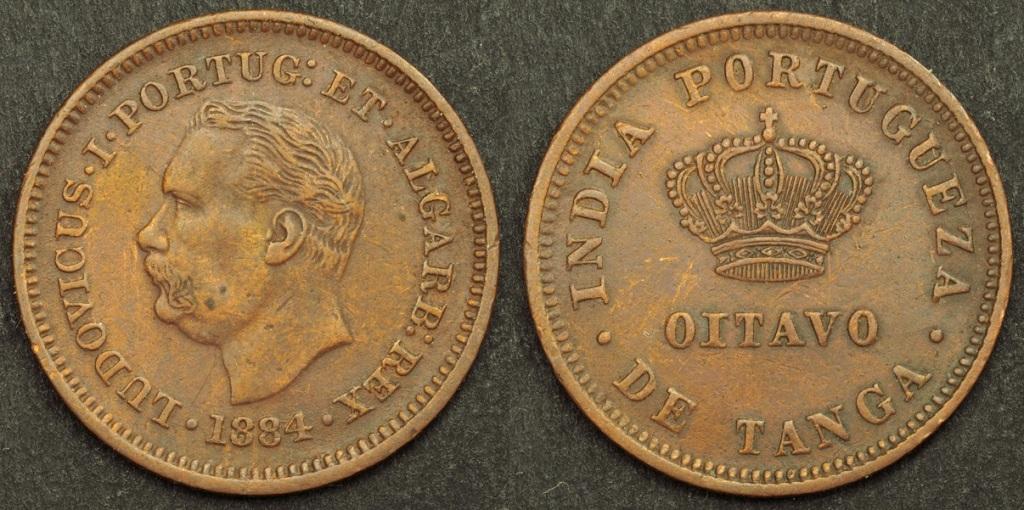 |
Same as above coin KM#307 1/8 Tanga
(7.5 Reis), but... Year:
1884.
Weight:
3.25g.
Mint:
Calcutta, India. |
|
 |
Same as above coin KM#307 1/8 Tanga
(7.5 Reis), but... Year:
1886.
Weight:
3.18g. Mint:
Calcutta, India. |
|
 |
KM#308 1/4 Tanga
(15 Reis). Year:
1881.
Weight:
6.49g.
Metal:
Bronze.
Diameter:
25.50 mm.
Edge: Plain.
Alignment:
Coin.
Mint:
Calcutta, India. |
|
Obverse Legend:
"LUDOVICUS · I · PORTUG : ET ·
ALGARB : REX" written around the Luiz I's portrait. Head of Luiz I facing left in the center. Date
"·1881·" at
the bottom.
Reverse Legend:
"INDIA PORTUGUEZA"
(Portuguese India) written at the
top section. Crown in the center. "·OITAVO DE TANGA·" (Quarter of the
Tanga) written at the bottom section.
Mintage: 7,242,000 (including
1884, 1886 and 1888 issues).
Minted Years:
1881, 1884, 1886 and 1888. Ruler:
Luiz I. |
|
 |
Same as above coin KM#308 1/4 Tanga
(15 Reis), but... Year:
1886.
Weight:
6.33g.
Mint:
Calcutta, India. |
|
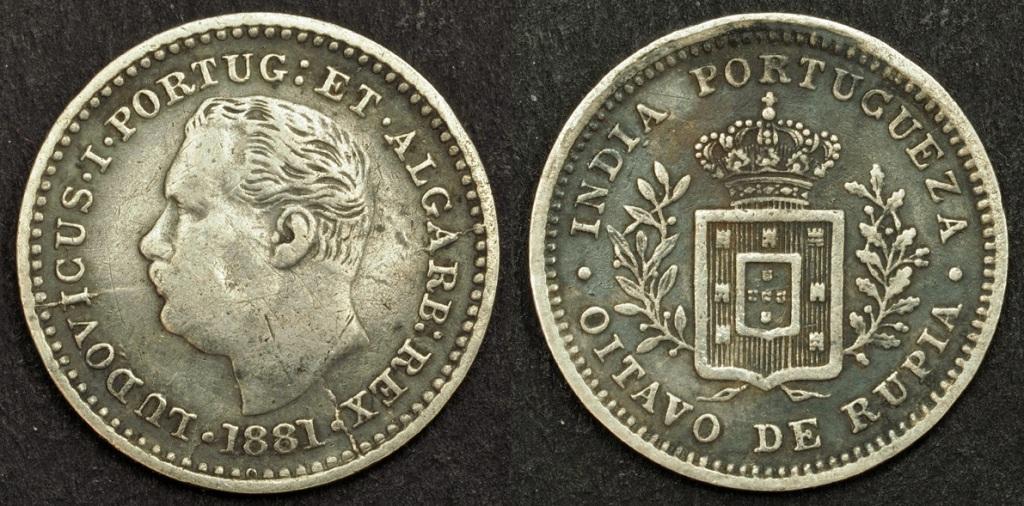 |
KM#309 1/8 Rupia.
Year:
1881.
Weight: 1.39g [1.46g].
Metal:
0.916 Silver.
Diameter:
14.00 mm.
Edge: Plain.
Alignment:
Coin.
Mint:
Calcutta, India. |
|
Obverse Legend:
"LUDOVICUS · I · PORTUG : ET ·
ALGARB : REX" written around the Luiz I's portrait. Head of Luiz I facing left in the center. Date
"·1881·" at
the bottom.
Reverse Legend:
"INDIA PORTUGUEZA"
(Portuguese India) written at the
top section. Crowned shield with wreath on both sides in
the center. "·OITAVO DE RUPIA·" (One Eighth of the
Rupee) written at the bottom section.
Mintage: 901,688.
Minted Years:
One year type. Ruler:
Luiz I. Note: The
above displayed coin is struck with broken obverse dies. |
|
 |
KM#310 1/4 Rupia.
Year:
1881.
Weight: 2.86g [2.92g].
Metal:
0.916 Silver.
Diameter:
19.00 mm.
Edge: Reeded.
Alignment:
Coin.
Mint:
Calcutta, India. |
|
Obverse Legend:
"LUDOVICUS · I · PORTUG : ET ·
ALGARB : REX" written around the Luiz I's portrait. Head of Luiz I facing left in the center. Date
"·1881·" at
the bottom.
Reverse Legend:
"INDIA PORTUGUEZA"
(Portuguese India) written at the
top section. Crowned shield with wreath on both sides in
the center. "·QUARTO DE RUPIA·" (Quarter of the
Rupee) written at the bottom section.
Mintage: 470,748.
Minted Years:
1881 and 1885. Ruler:
Luiz I. Note: 1885
issued in Proof only are are very rare. |
|
 |
KM#311 Half Rupia.
Year:
1881.
Weight: 5.71g [5.83g].
Metal:
0.916 Silver.
Diameter:
30.00 mm.
Edge: Reeded.
Alignment:
Coin.
Mint:
Calcutta, India. |
|
Obverse Legend:
"LUDOVICUS · I · PORTUG : ET ·
ALGARB : REX" written around the Luiz I's portrait. Head of Luiz I facing left in the center. Date
"·1881·" at
the bottom.
Reverse Legend:
"INDIA PORTUGUEZA"
(Portuguese India) written at the
top section. Crowned shield with wreath on both sides in
the center. "·MEIA RUPIA·" (Half
Rupee) written at the bottom section.
Mintage:
356,653
(including 1882 issue).
Minted Years: 1881, 1882 and
1885. Ruler:
Luiz I. Note: 1885
Dated coins are issued in Proof only and very rare. |
|
 |
Same as above coin KM#311
Half Rupia,
but... Year:
1882.
Weight: 5.69g [5.83g].
Mintage:
356,653
(including 1881 issue).
|
|
 |
KM#312 1 Rupia.
Year:
1882.
Weight: 11.55g [11.66g].
Metal:
0.916 Silver.
Diameter:
30.00 mm.
Edge: Reeded.
Alignment:
Coin.
Mint:
Calcutta, India. |
|
Obverse Legend:
"LUDOVICUS · I · PORTUG : ET ·
ALGARB : REX" written around the Luiz I's portrait. Head of Luiz I facing left in the center. Date
"·1881·" at
the bottom.
Reverse Legend:
"INDIA PORTUGUEZA"
(Portuguese India) written at the
top section. Crowned shield with wreath on both sides in
the center. "·UMA RUPIA·" (One
Rupee) written at the bottom section.
Mintage:
1,762,901
(including 1882 issue).
Minted Years: 1881, 1882,
1882 Medal alignment (very rare) and
1885 (in Proof and very rare). Ruler:
Luiz I. |
|
 |
Same as above coin KM#312 Rupia,
but... Year:
1882.
Weight: 11.51g [11.66g].
Mintage:
1,762,901
(including 1881 issue).
|
|
| |
|
Carlos
I - Portuguese Kingdom - Colonial coinage (1901, 1903-1904): |
|
Currency:
Rupia = 16 Tanga = 960 Reis. |
| |
Carlos (English: Charles I) the
Diplomat (also known as the Martyr; Portuguese: o Diplomata and
o Martirizado; 28 September 1863 – 01 February 1908), named
Carlos Fernando Luís Maria Víctor Miguel
Rafael Gabriel Gonzaga Xavier Francisco de Assis José Simão de
Bragança Sabóia Bourbon e Saxe-Coburgo-Gotha, was the
33rd (or 34th or 35th according to some historians) and
penultimate King of Portugal and the Algarves. He was the first
Portuguese king to die a violent death since Sebastian of
Portugal (1578). This occurred in 1908, when Carlos was murdered
in Lisbon as he travelled in an open carriage with the royal
family.
Carlos was born in Lisbon, Portugal, the son of King Luís and
Queen Maria Pia of Savoy, daughter of Victor Emmanuel II, King
of Italy. He had a brother, Infante Afonso, Duke of Porto.
His paternal first cousins included Frederick Augustus III of
Saxony, Princess Maria Josepha of Saxony, Prince Wilhelm of
Hohenzollern-Sigmaringen and Ferdinand I of Romania.
His maternal first cousins included Napoléon Victor Bonaparte,
Victor Emmanuel III of Italy, Emanuele Filiberto, 2nd Duke of
Aosta, Vittorio Emanuele, Count of Turin, Luigi Amedeo, Duke of
the Abruzzi, Umberto, Count of Salemi.
He had an intense education and was prepared to rule as a
constitutional monarch. In 1883 he traveled to Italy, England,
France and Germany where he increased his knowledge of the
modern civilization of his time. In 1883, 1886 and 1888 he ruled
as regent as his father was traveling in Europe, as it became
tradition among the Portuguese constitutional kings. His father
Luis I advised him to be modest and to study with focus.
His first bridal candidate was one of the daughters of Frederick
III, German Emperor, but the issue of religion presented an
insurmountable problem and the pressure of British diplomacy
prevented the marriage. He then met and married Princess Amélie
of Orléans, eldest daughter of Philippe, comte de Paris,
pretender to the throne of France.
Carlos became King on 19 October 1889. Colonial treaties with
the United Kingdom of Great Britain and Ireland (one signed in
August 1890 that defined their African borders along the Zambezi
and Congo rivers and another signed on 14 October 1899, that
confirmed colonial treaties of the 17th century) stabilised the
situation in Africa. These agreements were however unpopular in
Portugal where they were seen as being to the disadvantage of
the country.
Domestically, Portugal was twice declared bankrupt - on 14 June
1892, and again on 10 May 1902 - causing industrial
disturbances, socialist and republican antagonism and press
criticism of the monarchy. Carlos responded by appointing João
Franco as prime minister and subsequently accepting parliament's
dissolution.
As a patron of science and the arts, King Carlos took an active
part in the celebration of the 500th anniversary (in 1894) of
the birth of Prince Henry the Navigator. The following year he
decorated the famous Portuguese poet João de Deus in a ceremony
in Lisbon. Carlos took a personal interest in deep-sea and
maritime exploration, publishing an account of his own studies
in this area.
On 01 February 1908 the royal family returned from the palace of
Vila Viçosa to Lisbon. They travelled by train to Almada and
from there, they took a steamer to cross the Tagus River and
disembarked at Cais do Sodré in central Lisbon. On their way to
the royal palace, the open carriage with Carlos I and his family
passed through the Terreiro do Paço fronting on the river. While
crossing the square, shots were fired from the crowd by two
republican activists: Alfredo Costa and Manuel Buiça.
Buiça, a former army sergeant and sharpshooter, fired five shots
from a rifle hidden under his long overcoat. The king died
immediately, his heir, Luís Filipe, was mortally wounded, and
Prince Manuel was hit in the arm. The Queen alone escaped
injury. The two assassins were killed on the spot by police and
bodyguards; an innocent bystander was also killed in the
confusion. The royal carriage turned into the nearby Navy
Arsenal, where, about twenty minutes later, the Prince Royal
Luis Filipe died. Several days later, the younger son, Prince
Manuel, was proclaimed King of Portugal; he was the last of the
Braganza-Saxe-Coburg and Gotha dynasty and the last Portugal
king as well. |
| |
|
 |
KM#13 1/12 Tanga
(5 Reis). Year:
MCMI (1901).
Weight:
2.14g.
Metal:
Bronze.
Diameter:
18.00 mm.
Edge: Plain.
Alignment:
Coin.
Mint:
Lisbon. Obverse Legend:
CARLOS I REI DE PORTUGAL - MCMI.
Head of Carlos I facing right in the center. Date at the
bottom.
Reverse Legend:
INDIA PORTUGUEZA - 1/12 TANGA.
Crowned shield in center.
Mintage: 960,000.
Minted Years:
1901 and 1903. Ruler:
Carlos I.
Engraver:
Valancio Alves (Obverse side). |
|
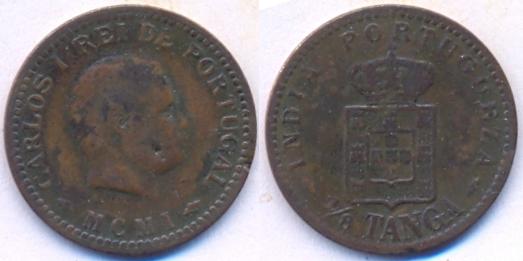 |
KM#14 1/8 Tanga
(7.5 Reis). Year:
MCMI (1901).
Weight:
2.95g.
Metal:
Bronze.
Diameter:
22.50 mm.
Edge: Plain.
Alignment:
Coin.
Mint:
N/A. Obverse Legend:
CARLOS I REI DE PORTUGAL - MCMI.
Head of Carlos I facing right in the center. Date at the
bottom.
Reverse Legend:
INDIA PORTUGUEZA - 1/8 TANGA.
Crowned shield in center.
Mintage: 960,000.
Minted Years:
1901 and 1903. Ruler:
Carlos I. |
|
 |
Same as above coin KM#14 1/8 Tanga
(7.5 Reis), but... Year:
MCMIII (1903).
Weight:
3.09g.
Mintage: 960,000. |
|
 |
KM#15 1/4 Tanga
(15 Reis). Year:
MCMI (1901).
Weight:
6.26g.
Metal:
Bronze.
Diameter:
25.00 mm.
Edge: Plain.
Alignment:
Coin.
Mint:
N/A. Obverse Legend:
CARLOS I REI DE PORTUGAL - MCMI.
Head of Carlos I facing right in the center. Date at the
bottom.
Reverse Legend:
INDIA PORTUGUEZA - 1/4 TANGA.
Crowned shield in center.
Mintage: 800,000.
Minted Years:
1901 and 1903. Ruler:
Carlos I. |
|
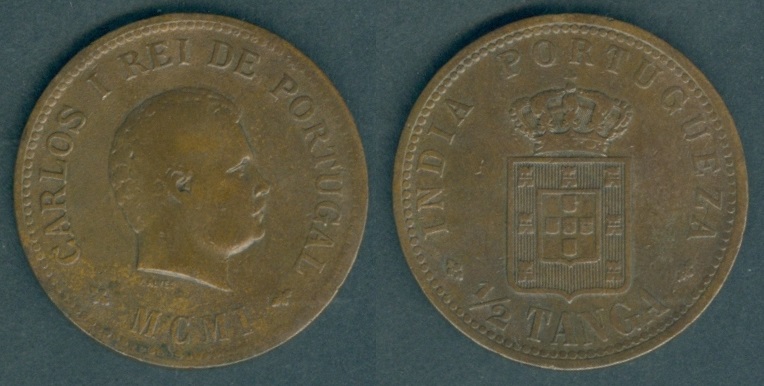 |
KM#16 1/2 Tanga
(30 Reis). Year:
MCMIII (1903).
Weight:
12.16g.
Metal:
Bronze.
Diameter:
30.00 mm.
Edge: Plain.
Alignment:
Coin.
Mint:
N/A. Obverse Legend:
CARLOS I REI DE PORTUGAL - MCMI.
Head of Carlos I facing right in the center. Date at the
bottom.
Reverse Legend:
INDIA PORTUGUEZA - 1/2 TANGA.
Crowned shield in center.
Mintage: 800,000.
Minted Years:
1901 and 1903. Ruler:
Carlos I. |
|
 |
Same as above coin KM#16 1/2 Tanga
(30 Reis), but... Year:
MCMIII (1903).
Weight:
12.02g.
Mintage:
800,000. |
|
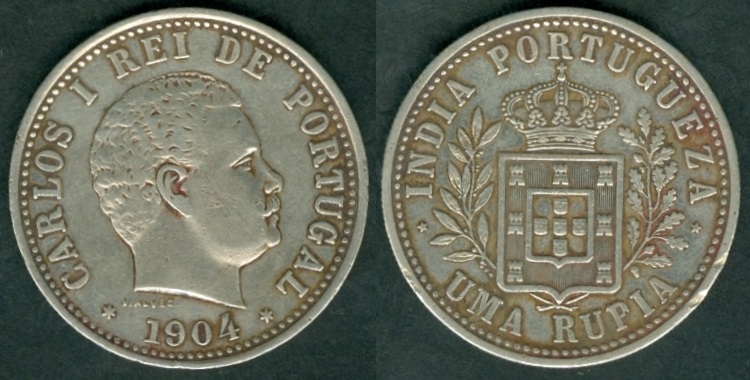 |
KM#17 1 Rupia.
Year:
1904.
Weight: 11.64g [11.66g].
Metal:
0.916 Silver.
Diameter:
30.00 mm.
Edge: Reeded.
Alignment:
Coin.
Mint:
N/A. Obverse Legend:
CARLOS I REI DE PORTUGAL - MCMI.
Head of Carlos I facing right in the center. Date at the
bottom.
Reverse Legend:
INDIA PORTUGUEZA * UMA RUPIA *.
Crowned shield in the center with wreath on both sides.
Mintage: 100,000.
Minted Years:
1903 and 1904. Ruler:
Carlos I. |
|
| |
|
Portuguese Republic
Administration - Colonial Coinage (1912): |
|
Under Portuguese India Governor-General:
Francisco Manuel Couceiro da Costa
(12 Oct 1910 - 03 Jul 1917). |
|
Currency:
Rupia. |
| |
|
 |
KM#18 1 Rupia.
Year:
1912.
Weight: 11.62g [11.66g].
Metal:
0.916 Silver.
Diameter:
30.00 mm.
Edge: Reeded.
Alignment:
Coin.
Mint:
N/A. Obverse Legend:
"REPUBLICA PORTUGUESA" at the top.
Liberty head facing left in the center. Date at the
bottom.
Reverse Legend:
Denomination "INDIA * UMA RUPIA"
within wreath on both sides.
Mintage: 300,000.
Minted Years:
1912/1 and 1912. |
|
| |
|
Portuguese Republic
Administration - Colonial Coinage (1934-1936): |
|
Under Portuguese India Governor-General:
João Carlos Craveiro Lopes (25
Aug 1929 - 17 Sep 1936). |
|
Currency:
Rupia = 16 Tanga = 960 Reis. |
| |
|
 |
KM#19 1 Tanga (60
Reis). Year:
1934.
Weight: 3.92g.
Metal:
Bronze.
Diameter:
22.00 mm.
Edge: Plain.
Alignment:
Medal.
Mint:
N/A. Obverse Legend:
"REPUBLICA PORTUGUESA" at the top.
Divided shield in center. Date at the bottom.
Reverse Legend:
ESTADO DA INDIA. Five shields in
one shield in center. "1 tanga" at the bottom.
Mintage: 100,000.
Minted Years:
One year type. Note:
This is the only Portuguese
India coin in my collection to be of Medal alignment. |
|
 |
KM#20 2 Tanga (120
Reis). Year:
1934.
Weight: 2.96g.
Metal:
Copper-Nickel.
Diameter:
19.00 mm.
Edge: Plain.
Alignment:
Coin.
Mint:
N/A. Obverse Legend:
"REPUBLICA PORTUGUESA" at the top.
Divided shield in center. Date at the bottom.
Reverse Legend:
ESTADO DA INDIA. Five shields in
one shield in center. "2 tangas" at the bottom.
Mintage: 150,000.
Minted Years:
One year type. |
|
 |
KM#23 1/2 Rupia.
Year:
1936.
Weight: 5.70g [6.00g].
Metal:
0.917 silver.
Diameter:
25.00 mm.
Edge: Reeded.
Alignment:
Coin.
Mint:
N/A. Obverse Legend:
REPUBLICA PORTUGUESA 1935. Shield
on lined circle at center of Maltese Cross.
Reverse Legend:
ESTADO DA INDIA 1/2 rupia. Divided
shield in center. Mintage:
100,000.
Minted Years:
One year type. |
|
 |
KM#22 1 Rupia.
Year:
1935.
Weight: 11.55g [12.00g].
Metal:
0.917 silver.
Diameter:
30.00 mm.
Edge: Reeded.
Alignment:
Coin.
Mint:
N/A. Obverse Legend:
REPUBLICA PORTUGUESA 1935. Shield
on lined circle at center of Maltese Cross.
Reverse Legend:
ESTADO DA INDIA 1 rupia. Divided
shield in center. Mintage:
300,000.
Minted Years:
One year type. |
|
| |
|
Portuguese Republic
Administration - Overseas Province Coinage: |
|
Under Portuguese India Governor-General:
Fernando Quintanilha Mendonça e
Dias [acting]
(03 Aug 1947 - 27 Jun 1948 and 23 Dec 1948 - 1952). |
|
Currency:
Rupia = 16 Tanga = 960 Reis. |
| |
|
1947 |
|
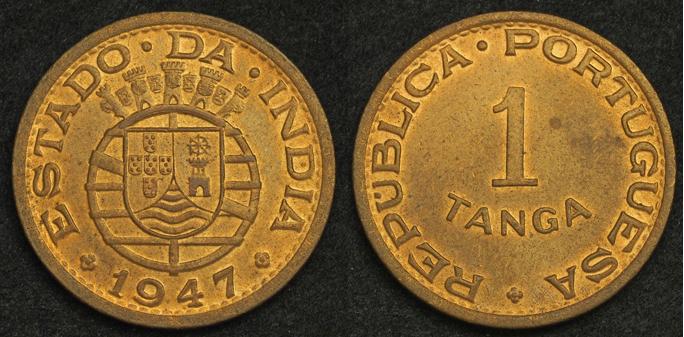 |
KM#24 1 Tanga.
Year:
1947.
Weight: 5.88g.
Metal:
Bronze.
Diameter:
24.50 mm.
Edge: Plain.
Alignment:
Coin.
Mint:
N/A. Obverse Legend:
ESTADO DA INDIA 1947. Divided
shield with arms within globe, topped by crown of five
turrets. Reverse Legend:
REPUBLICA PORTUGUESA 1
TANGA. Mintage:
1,000,000.
Minted Years:
One year type. |
|
 |
KM#25 1/4 Rupia.
Year:
1947.
Weight: 3.69g.
Metal:
Copper-Nickel.
Diameter:
18.50 mm.
Edge: Reeded.
Alignment:
Coin.
Mint:
N/A. Obverse Legend:
ESTADO DA INDIA 1947. Tiny towers
and shields above divided shield on lined circle.
Reverse Legend:
REPUBLICA PORTUGUESA 1/4 RUPIA.
Mintage: 800,000.
Minted Years:
1947 and 1952. |
|
 |
KM#26 1/2 Rupia.
Year:
1947.
Weight: 5.42g.
Metal:
Copper-Nickel.
Diameter:
24.00 mm.
Edge: Reeded.
Alignment:
Coin.
Mint:
N/A. Obverse Legend:
ESTADO DA INDIA 1947. Divided
shield with arms within globe, topped by crown of five
turrets. Reverse Legend:
REPUBLICA PORTUGUESA 1/2
RUPIA. Mintage:
600,000.
Minted Years:
1947 and 1952. |
|
 |
KM#27 1 Rupia.
Year:
1947.
Weight: 12.01g [12.00g].
Metal:
0.500 silver.
Diameter:
30.00 mm.
Edge: Reeded.
Alignment:
Coin.
Mint:
N/A. Obverse Legend:
REPUBLICA PORTUGUESA 1947. Shield
on lined circle at center of Maltese Cross.
Reverse Legend:
ESTADO DA INDIA 1 rupia. Divided
shield with arms within globe, topped by crown of five
turrets. Mintage:
900,000.
Minted Years:
One year type. |
|
| |
|
1952 |
|
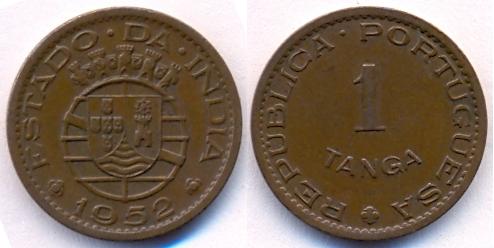 |
KM#19 1 Tanga (60
Reis). Year:
1952.
Weight: 3.95g.
Metal:
Bronze.
Diameter:
22.00 mm.
Edge: Plain.
Alignment:
Coin.
Mint:
N/A. Obverse Legend:
ESTADO DA INDIA 1952. Tiny towers
and shields above divided shield on lined circle.
Reverse Legend:
REPUBLICA PORTUGUESA 1 TANGA.
Mintage: 960,000.
Minted Years:
One year type. |
|
 |
KM#26 1/2 Rupia.
Year:
1952.
Weight: 5.57g.
Metal:
Copper-Nickel.
Diameter:
24.00 mm.
Edge: Reeded.
Alignment:
Coin.
Mint:
N/A. Obverse Legend:
ESTADO DA INDIA 1952. Tiny towers
and shields above divided shield on lined circle.
Reverse Legend:
REPUBLICA PORTUGUESA 1/2 RUPIA.
Mintage: 2,000,000.
Minted Years:
1947 and 1952. |
|
 |
KM#29 1 Rupia.
Year:
1952.
Weight: 12.03g.
Metal:
Copper-Nickel.
Diameter:
30.00 mm.
Edge: Reeded.
Alignment:
Coin.
Mint:
N/A. Obverse Legend:
REPUBLICA PORTUGUESA 1952. Shield
on lined circle at center of Maltese Cross.
Reverse Legend:
ESTADO DA INDIA 1 RUPIA.
Tiny towers and shields
above divided shield on lined circle.
Mintage: 1,000,000.
Minted Years:
One year type. |
|
| |
| |
|
Portuguese Republic
Administration - Overseas Province Coinage: |
|
Under Portuguese India Governor-General:
Manuel António Vassalo e Silva (1958
- 1962). |
|
Currency:
Escudo = 100 centavos. |
| |
|
1958 |
|
 |
KM#30 10 centavos.
Year:
1958.
Weight: 1.98g [2.00g].
Metal:
Bronze.
Diameter:
18.00 mm.
Edge: Plain.
Alignment:
Coin.
Mint:
N/A. Obverse Legend:
ESTADO DA INDIA 1958. Tiny towers
and shields above divided shield on lined circle.
Reverse Legend:
REPUBLICA PORTUGUESA 10 centavos.
Mintage: 5,000,000
(including 1959). Minted
Years: 1958, 1959 and 1961. |
|
 |
KM#31 30 centavos.
Year:
1958.
Weight: 3.99g [4.00g].
Metal:
Bronze.
Diameter:
21.50 mm.
Edge: Plain.
Alignment:
Coin.
Mint:
N/A. Obverse Legend:
ESTADO DA INDIA 1958. Tiny towers
and shields above divided shield on lined circle.
Reverse Legend:
REPUBLICA PORTUGUESA 30 centavos.
Mintage: 5,000,000
(including 1959). Minted
Years: 1958 and 1959. |
|
 |
KM#32 60 centavos.
Year:
1958.
Weight: 3.57g [3.50g].
Metal:
Copper-Nickel.
Diameter:
20.00 mm.
Edge: Plain.
Alignment:
Coin.
Mint:
N/A. Obverse Legend:
ESTADO DA INDIA 1958. Shield on
lined circle at center of Maltese Cross.
Reverse Legend:
REPUBLICA PORTUGUESA $ 60.
Tiny towers and shields
above divided shield on lined circle.
Mintage: 5,000,000
(including 1959). Minted
Years: 1958 and 1959. |
|
 |
KM#33 Escudo.
Year:
1958.
Weight: 5.62g [5.65g].
Metal:
Copper-Nickel.
Diameter:
24.00 mm.
Edge: Plain.
Alignment:
Coin.
Mint:
N/A. Obverse Legend:
ESTADO DA INDIA 1958. Shield on
lined circle at center of Maltese Cross.
Reverse Legend:
REPUBLICA PORTUGUESA 1$00.
Tiny towers and shields
above divided shield on lined circle.
Mintage: 6,000,000
(including 1959). Minted
Years: 1958 and 1959. |
|
 |
KM#34 3 Escudo.
Year:
1958.
Weight: 7.89g [8.00g].
Metal:
Copper-Nickel.
Diameter:
26.50 mm.
Edge: Reeded.
Alignment:
Coin.
Mint:
N/A. Obverse Legend:
ESTADO DA INDIA 1958. Shield on
lined circle at center of Maltese Cross.
Reverse Legend:
REPUBLICA PORTUGUESA 3$00.
Tiny towers and shields
above divided shield on lined circle.
Mintage: 5,000,000
(including 1959). Minted
Years: 1958 and 1959. |
|
| |
|
1959 |
|
 |
KM#30 10 centavos.
Year:
1959.
Weight: 2.00g [2.00g].
Metal:
Bronze.
Diameter:
18.00 mm.
Edge: Plain.
Alignment:
Coin.
Mint:
N/A. Obverse Legend:
ESTADO DA INDIA 1959. Tiny towers
and shields above divided shield on lined circle.
Reverse Legend:
REPUBLICA PORTUGUESA 10 centavos.
Mintage: 5,000,000
(including 1958). Minted
Years: 1958, 1959 and 1961. |
|
 |
KM#31 30 centavos.
Year:
1959.
Weight: 3.97g [4.00g].
Metal:
Bronze.
Diameter:
21.50 mm.
Edge: Plain.
Alignment:
Coin.
Mint:
N/A. Obverse Legend:
ESTADO DA INDIA 1959. Tiny towers
and shields above divided shield on lined circle.
Reverse Legend:
REPUBLICA PORTUGUESA 30 centavos.
Mintage: 5,000,000
(including 1958). Minted
Years: 1958 and 1959. |
|
 |
KM#32 60 centavos.
Year:
1959.
Weight: 3.49g [3.50g].
Metal:
Copper-Nickel.
Diameter:
20.00 mm.
Edge: Plain.
Alignment:
Coin.
Mint:
N/A. Obverse Legend:
ESTADO DA INDIA 1959. Shield on
lined circle at center of Maltese Cross.
Reverse Legend:
REPUBLICA PORTUGUESA $ 60.
Tiny towers and shields
above divided shield on lined circle.
Mintage: 5,000,000
(including 1958). Minted
Years: 1958 and 1959. |
|
 |
KM#33 Escudo.
Year:
1959.
Weight: 5.52g [5.65g].
Metal:
Copper-Nickel.
Diameter:
24.00 mm.
Edge: Plain.
Alignment:
Coin.
Mint:
N/A. Obverse Legend:
ESTADO DA INDIA 1959. Shield on
lined circle at center of Maltese Cross.
Reverse Legend:
REPUBLICA PORTUGUESA 1$00.
Tiny towers and shields
above divided shield on lined circle.
Mintage: 6,000,000
(including 1958). Minted
Years: 1958 and 1959. |
|
 |
KM#34 3 Escudo.
Year:
1959.
Weight: 8.10g [8.00g].
Metal:
Copper-Nickel.
Diameter:
26.50 mm.
Edge: Reeded.
Alignment:
Coin.
Mint:
N/A. Obverse Legend:
ESTADO DA INDIA 1959. Shield on
lined circle at center of Maltese Cross.
Reverse Legend:
REPUBLICA PORTUGUESA 3$00.
Tiny towers and shields
above divided shield on lined circle.
Mintage: 5,000,000
(including 1958). Minted
Years: 1958 and 1959. |
|
 |
KM#35 6 Escudo.
Year:
1959.
Weight: 13.97g [14.00g].
Metal:
Copper-Nickel.
Diameter:
30.50 mm.
Edge: Reeded.
Alignment:
Coin.
Mint:
N/A. Obverse Legend:
ESTADO DA INDIA 1959. Shield on
lined circle at center of Maltese Cross.
Reverse Legend:
REPUBLICA PORTUGUESA 6$00.
Tiny towers and shields
above divided shield on lined circle.
Mintage: 4,000,000.
Minted Years:
One year type. |
|
| |
|
1961 |
|
 |
KM#30 10 centavos.
Year:
1961.
Weight: 2.00g [2.00g].
Metal:
Bronze.
Diameter:
18.00 mm.
Edge: Plain.
Alignment:
Coin.
Mint:
N/A. Obverse Legend:
ESTADO DA INDIA 1958. Tiny towers
and shields above divided shield on lined circle.
Reverse Legend:
REPUBLICA PORTUGUESA 10 centavos.
Mintage: 1,000,000.
Minted Years:
1958, 1959 and 1961.
Note: This is the last coin of Portuguese India. |
|
| |
| |
|
Early Indian coins:
British India coins:
Coins of Indian Princely States and
other colonies:
Coins of "Republic of India" sorted under below
Presidential rulers:
Others:
|
|
|
|
|
| |
|
|
| |
|
India |
|
Countries / Territories |
| |
|
Chiefa Coins |
|
|














































